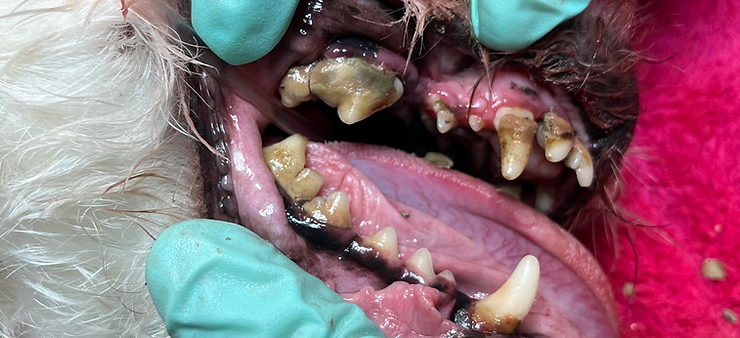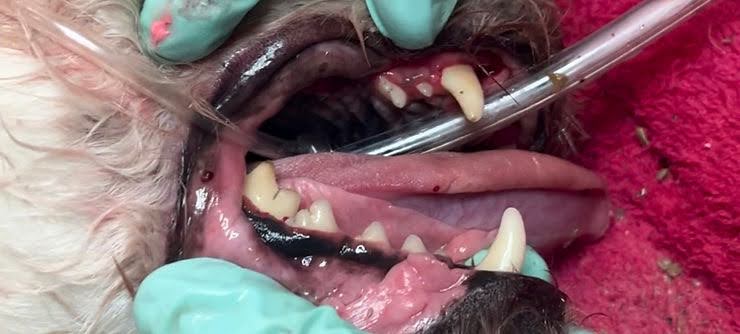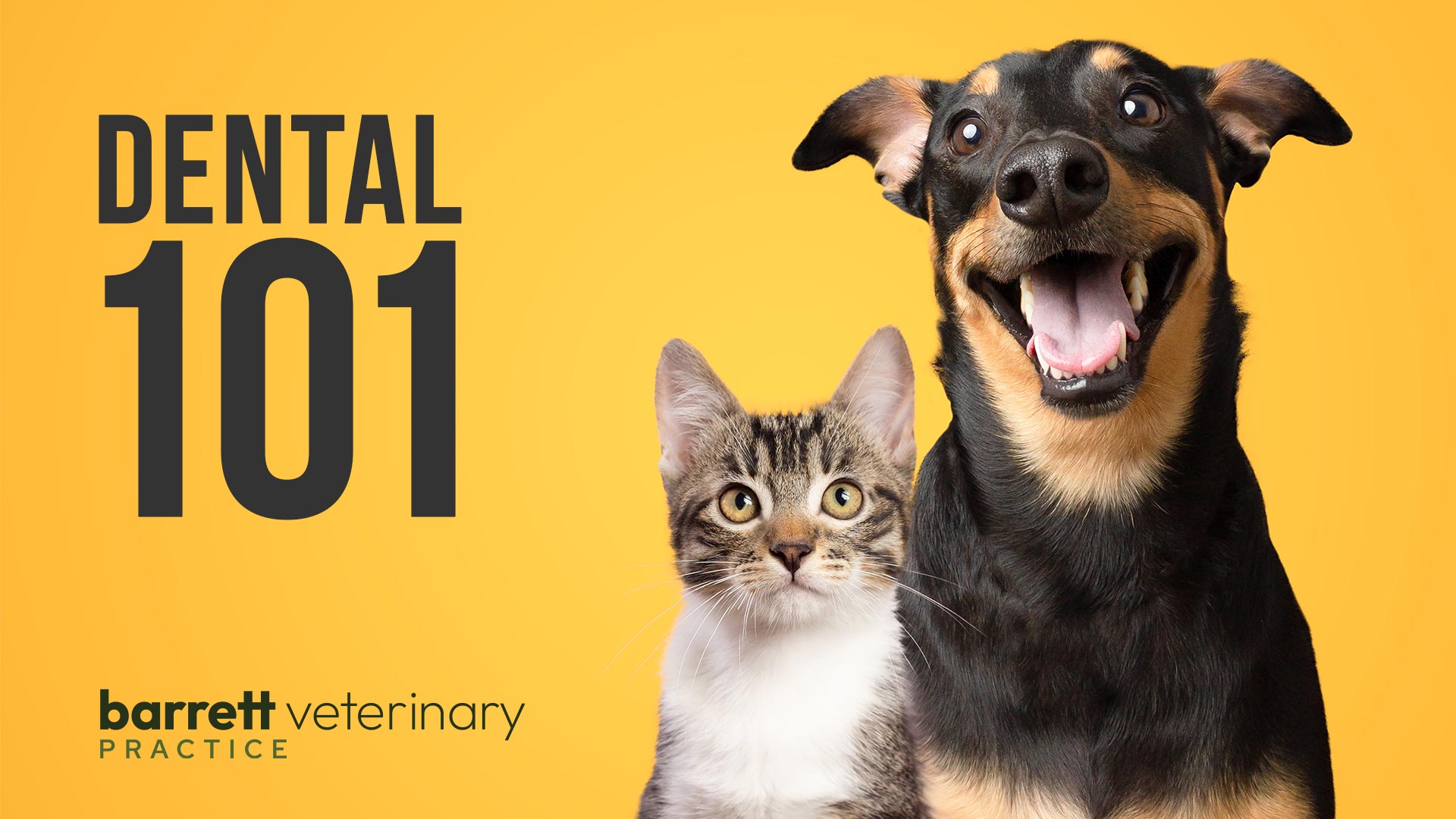Dental 101
Did you know – Dental disease is one of the most common medical conditions seen by veterinarians? We spend most of our days looking in stinky mouths! Over 80% of dogs over the age of three have active dental disease. One of the most common dental problems seen in dogs are periodontal disease and fractured teeth – ouch 😓
Have you noticed any of these symptoms in your pet?
- Bad breath – eeeew!
- Extra teeth or retained baby teeth
- Teeth that are discolored or covered in tartar
- Abnormal chewing, drooling, or dropping food from the mouth
- Reduced appetite or refusal to eat (even the tastiest things)
- Pain in or around the mouth – becoming irritable when their face is touched
- Bleeding from the mouth
- Swelling in the areas surrounding the mouth
Any of these symptoms should prompt a visit to us for a dental quote or a medical exam!
Understanding and receiving a dental quote
If you think your pet is in need of a dental cleaning we offer a free (woohoo) dental estimate in-person appointment with one of our ✨superstar✨ dental techs. During this five-minute appointment, she will take a sneaky peak at your pet’s teeth and give you an estimate with a range, as we can’t predict everything your pet will need the range will include the services that she thinks your pet may need: our quotes always include xrays and a scale and polish, we may add in variables which are dependent on what we find during the procedure. The variables may be extractions, blood work, medications, and extra services that you may like to include, for example, vaccinations, anal gland expressions, toe nail trims, etc.
If you can’t make it in clinic for an estimate, and you’ve already received a recent quote from another veterinarian shoot that estimate over to us and we can virtually give you a comparative estimate, we pride ourselves on our fair pricing!
We also encourage owners to let us know about any little lumps and bumps, they may notice on their furry friends, when receiving an estimate, as we can also quote for the additional surgery time needed to remove them! Saves you an extra trip back in the future 😉
A glimpse into how we price our dentals:
Each of our estimates is tailor made, to include what we *think* your pet will need during their procedure. We use dental packages, so that we can bundle our items which we hope makes them easier to understand and so that you aren’t nickel and dimed over the little things.
Understanding your quote:
Dental #1: We are seeing mild tartar around the gum line and inflamed gums, we think your pet may just need a cleaning and polish and no extractions.
Dental #1- #2: We are giving you a range between two of our packages, there is varying levels of tartar, the build up could be mild to severe with inflammation around the gums, we are anticipating that your pet will possibly need 1-2 extractions.
Dental #2 – #3: A good cleaning is needed as there is a lot of build up and inflammation, we anticipating that over four extractions are needed.
Dental #4: We are seeing severe build up, usually a “Dental #4” indicates that a full mouth extraction (or close too) is needed!

What happens during a dental procedure at Barrett Veterinary Practice?
On the morning of the dental procedure, your furry friend will arrive at the clinic and be greeted by the Barrett Crew. During your admission appointment our dental tech will go through the intake form and do her best to ease any pet parent concerns!
From here your pets journey to improved dental health will start, they will get settled into their cosy (we are talking about, fluffy blankets… heating pads, the whole deal) kennel. If your pet is nervous, we will premed them with a calming medication. We want your pet to have the best experience with us, so just like with some humans at the dentist, having a medication prior to the procedure can calm any nerves.
The pre operation exam is conducted next, we listen to the heart, take temperatures and whisper sweet nothings into each others ears… an important part of our pre op process is blood work. Conducting blood work helps Dr Barrett and our friendly crew of vet techs pick the appropriate drug combination to give your pet for sedation, anesthesia, and pain control. Knowing how your dog or cat’s organs are functioning allows Dr B to tailor your pet’s medications to their specific needs, which helps decrease possible side effects of any medications given in clinic.
Many pet parents don’t realise the importance of of blood work, and thats okay! We are here to guide you in the process. If a human is going under sedation, or has a health concern usually blood work is one of the first things your doctor will conduct as part of your treatment plan. It can pick up on internal issues that cannot be seen or are still too subtle to pick up on a physical exam. The same goes for your faithful friend.
Once we’ve received the blood work results from our in house blood work machines, it’s time for sedation and prepping for the dental, we place a catheter for IV fluids and medications if needed, keeping your pet on fluids during a procedure helps then metabolise any drugs they are given which in turn helps protect the kidneys and liver, they also help keep blood pressure stable, hydration levels up and in turn helps them recover quicker.
Next step is to take full mouth x-rays, because your pet is sedated we can take beautiful xrays to fully evaluate the periodontal health of your pet’s mouth and to make sure that no “hidden” disease is present and waiting to flare up (like brewing tooth root infections or resorbed tooth roots). If during the xrays we find any damaged teeth, that may cause future problems or currently are a problem we will extract them. After we have plucked those pesky teeth, we go in and remove plaque and tartar from the teeth and polish them – to give your pet a sparkly new smile! 😊
Once the whole mouth has been scaled and polished and the smell of fresh breath is in the air, we start to wake them up from their good snooze and put them into recovery. We will notify the worried pet parent to let them know that everything went well, for the rest of the afternoon we make your furry pal all cosy and comfy and monitor them ready for their discharge appointment.
Results
Sometimes it’s easier to understand with pictures – Here is what we would consider a “Dental #3 – #4” it’s clear with that build up that good cleaning is needed there is inflammation around the gum line, we are anticipating that over four extractions are needed upon presentation.

Here is the result, after viewing the xrays we ended up extracting fourteen teeth and gave this little girls remaining twenty three teeth a good old cleaning, her owner reported that after her dental she started acting like a puppy again! 😊

Did you know the average dental is 2hr – 3hrs long! 🦷
Recovery:
Once you’ve had your discharge appointment and you take your pet home, you may notice some grogginess, drooling, or drowsiness for several hours – that’s okay, it’s part of the process. They’re typically almost back to normal self (often even better, as the discomfort their dental and periodontal disease had been causing them is now gone) by the next day. If at any point you’re concerned, don’t hesitate to call us for advice.
… but, but.. i’ve heard sedation free dentals are better for my pet?
In recent years anesthetsia free cleanings, have grown in popularity, as many owners can be nervous about putting their pets under anaesthesia for cleanings. As pet owners we understand this and sympathise, but here are a few reasons why we recommend a full dental procedure:
A thorough oral examination cannot be performed until the animal is under anesthesia so probing and measuring can be done below the gum line and between the teeth, and the entire oral cavity can be examined completely.
80% of periodontal disease is below the gum line where you can’t see it. This part cannot be cleaned during a nonprofessional dental cleaning.
We conduct oral X-rays with every dental procedure, so we can check the integrity of the teeth, anesthesia is necessary for those.
During a nonprofessional dental cleaning, the animal will be restrained while the tartar is removed. In some cases, this is stressful and painful. You thought it was hard to brush their teeth before!
How can I prevent tartar accumulation after the procedure?
Plaque forms in as little as six hours after your pet eats! If allowed to remain on the tooth’s surface, plaque thickens and mineralizes resulting in tartar. Tartar is a rough material which attracts more plaque to “stick” to the tooth surface. This means that if you aren’t brushing your pets teeth every day religiously, you must be aware that preventative dentals are on the cards.
Pet food manufacturers have developed dental diets that can help reduce the formation of plaque and tartar on your dog’s teeth, which is one great tool in the toolkit.
Once tartar has formed, however, professional scaling and polishing under general anesthesia will be needed as it cannot easily be removed by diets and/or brushing.


